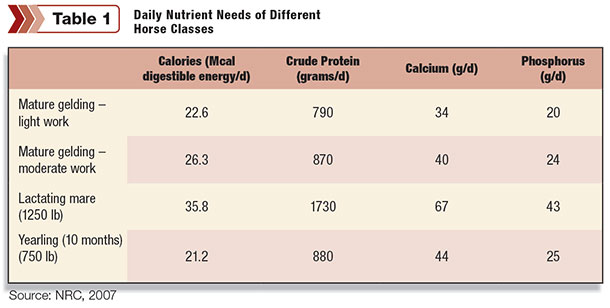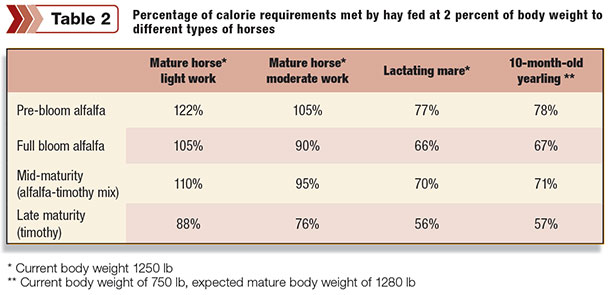Cleanliness
Inflammation of the respiratory tract can negatively impact respiratory function, and hay can be a source of inflammatory substances.
Breathable particles from hay that can cause respiratory inflammation include mold, pollen, small hay particles and small soil particles.
A recent evaluation of various hay-making conditions indicated that baling at 15 percent moisture reduced breathable dust particles and viable mold spores compared to baling at 25 percent moisture.
Application of propionic acid preservative to the higher-moisture hay mitigated the increase in breathable dust and mold spores. This project also reported that rainfall post-cutting could increase the dust and mold spores in the hay.
Cleanliness also pertains to the presence of unwanted plants or other contaminants in the hay.
Clearly, the inclusion of potential poisonous plants should be avoided; however, plants such as thistles and nettles, which have the potential to be physically injurious to the horse’s mouth, are also undesirable.
Consistency
Colic, or acute abdominal pain, can be brief and insignificant or severe and life-threatening. Colic can be caused by something as simple as momentary accumulation of gas in the gastrointestinal tract or by impactions or obstructions that can only be resolved with abdominal surgery.
According to a study conducted by the USDA, colic accounted for 15 percent of all deaths in horses more than 6 months old.
A number of dietary factors have been associated with increased colic risk, including restricting or eliminating grazing, amount of concentrate (grain) consumed, and type of hay fed.
Dietary change has been suggested as one of the leading risk factors for equine colic. In a recent review of several epidemiological studies in equine colic, it was suggested that a change in hay (variety, load) is a greater risk factor for colic than a change in concentrate type.
Some horse owners are unable to differentiate orchardgrass from timothy, but most can identify a change in hay based on color, texture and acceptability to their horses.
Consistency in hay type and quality is also important from a nutritional perspective. Many horse owners do not appreciate the large differences in nutritional composition between various types of hay.
In urban and suburban environments, horses are often kept in boarding facilities where the horse receives a constant amount of concentrate every day regardless of whether the hay changes.
Consequently, an increase in hay quality can inadvertently result in an increase in nutrient intake, while a decrease in hay quality can reduce nutrient intake.
Convenience
Convenience doesn’t matter to horses, but it does matter to horse owners. Bale size is very important to many horse owners. Small rectangular bales are still preferred by many horse owners because they are easier to handle.
Bales that weigh 50 to 60 pounds can be managed by most horse owners, whereas bales that weigh more than 100 pounds are more difficult to move.
Stabled horses are usually offered hay twice a day; therefore, bales that permit portion sizes of 5 to 15 pounds are desirable.
While the traditional-size bale is still popular with many horse owners, large bales (round or rectangular) can be a convenient means of feeding hay to horses kept in groups in drylots or paddocks.
Large bales that are mold-free and have been stored inside can be used for horses, whereas bales that have been stored outside do not meet the cleanliness requirements described previously.
Large bales can become moldy in the field if they are not consumed rapidly. Therefore it is best if large bales are used for relatively large groups of horses that consume the bale in just a few days.
Composition
The most effective horse-feeding programs match the nutrient composition of the hay to the nutrient requirements of the horse.

Table 1 shows the daily calorie, protein, calcium and phosphorus requirements of several different types of horses.
The needs of mature horses used for light exercise (one to three hours per week) and moderate exercise (three to five hours per week) are low compared to the needs of a lactating mare.
Although the absolute amounts needed by a young growing horse are not higher than mature horses in moderate work, they are much higher in relation to bodyweight.
Consequently, mature horses that are sedentary or are used for light exercise can be fed hays with lower nutrient density than broodmares, growing horses or elite equine athletes.
In general, the most nutrient-dense (nutrients per pound) hays are the early maturity legumes and the least nutrient-dense hays are the late-maturity grasses.
Table 2 shows how effectively different types of hay meet the calorie needs of four different types of horses: a mature horse in light work, a mature horse in moderate work, a lactating mare and a 10-month-old yearling.
When looking at Table 2, it becomes clear that some hays are better suited to certain types of horses than others.
Feeding pre-bloom alfalfa at 2 percent of bodyweight results in a calorie intake that is about 20 percent above the requirement for a horse in light work.
These extra calories would be stored as fat. Eventually, using this hay at this rate will result in a very fat horse. If this hay was fed at a rate to meet the calorie needs of the horse in light work, intake would have to be restricted to approximately 1.6 percent of bodyweight.
Restricting feed intake is certainly possible, but it may lead to some undesirable behaviors, such as wood chewing.
A better choice for the horse in light work would be to feed the full-bloom alfalfa at a slightly restricted rate or to feed the late-maturity timothy, either at a higher rate or in combination with a commercial concentrate.
By feeding a small amount of commercial concentrate, the trace nutrient needs of the horse (trace minerals, vitamins) will be met.
For the lactating mare and the growing horse, the late-maturity timothy hay is the least desirable choice. At this rate of intake, relatively large amounts of concentrate would be needed to meet calorie needs for growing horses and lactating mares fed late-maturity timothy.
If only hay was available, these horses would have to eat almost 4 percent of their bodyweight to meet their calorie requirements, which is very unlikely.
The pre-bloom alfalfa or the mid-maturity alfalfa-timothy mix hays come closer to meeting the calorie requirements for broodmares and growing horses than the late-maturity timothy.
Because these hays meet a larger percentage of the calorie needs, it will be possible to use less concentrate.
Cost-effectiveness
The cost of hay is often a concern of horse owners. But it is important to realize that “cost” and “cost-effectiveness” are not synonymous.
Cost is best thought of as price per ton, but cost-effectiveness takes into consideration the value of the hay in relation to the total diet cost.
Hays with higher nutrient densities are more valuable because they reduce the amount of supplementation needed in the total diet.
In addition, hays with higher nutrient densities are usually more palatable and more digestible, so there is less waste. FG
Laurie Lawrence is with the department of animal sciences at the University of Kentucky.
Email us at Progressive Forage Grower if you would like a reproducible copy of this article to distribute to your horse-hay customers.
References omitted due to space but are available upon request. Click here to email an editor.










